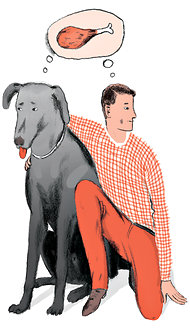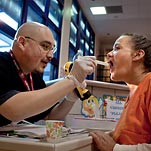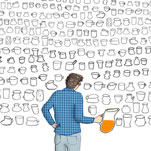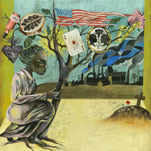“We wanted another family member, someone to fill out the cast, a supporting actress,” John Homans, the executive editor at New York magazine, writes in his engaging and informative book that is both a survey of the latest research on canine cognition and a memoir of his years with his Lab mix, Stella. As a puppy, Stella found her way from Tennessee to an animal shelter near New York City. Even at 12 weeks old and locked in a cage, she seemed “self-possessed, happy for attention but not demanding it,” the author recalls. The Homans family took to her immediately and adopted her to be a companion for their soon-to-be 10-year-old son — thereby bringing the comedic and mysterious presence of canine intelligence into their lives.
Made for Each Other
‘What’s a Dog For?’ by John Homans
By WALTER VATTER
Published: January 4, 2013
WHAT’S A DOG FOR?
The Surprising History, Science, Philosophy, and Politics of Man’s Best Friend
By John Homans
258 pp. The Penguin Press. $25.95.
Related
Times Topic: Dogs
Curious about how Stella’s brain works and how she adapted to her new family, Homans seeks out experts who can explain “the strangeness of having this predator in my home, lying on her back, waiting to get her stomach scratched.” He meets with scientists, trainers and breeders to understand why so many of us bond with dogs, and why dog ownership is on the rise. There were 77 million dogs in America in 2010, up from 53 million in 1996. “We’ve seen a linear explosion in pet populations in Western countries over the past 40 years,” one researcher says. “People are living more isolated lives, are having fewer children, their marriages aren’t lasting. All these things sort of break down a social network and happen to exactly coincide with the growth in pet populations. What’s happening is simply that we’re allowing animals to fill the gap in our lives.”
But what enables dogs to fill this gap? The new canine science is trying to answer this very question. The core, and controversial, theory is “convergence”: that living closer to humans has made dogs more like humans. “Wolves became dogs because, in prehistory, they were engaged in the same kinds of activities as humans, and in their shared interests, the two species forged a brotherhood,” Homans explains. “Canine science is intended to shed light not only on what makes dogs dogs but also on what makes people people.”
The centerpiece of the book, which covers everything from the evolution of the Labrador retriever to the politics of ethical dog ownership, is the second Canine Science Forum at the University of Vienna, an international conference devoted to the dog. Lecturers present evidence from “provinces where science has seldom gone — the living room, the street corner, the dog run.” Anyone who has known the pleasures of clear back-and-forth communication with a loyal canine companion will be fascinated by new studies on “the language of gesture.” Dogs’ ability to understand what a pointing motion signifies (something even our primate cousins can’t do) means that they are uniquely responsive to our behavior. For generations, “dogs have been specifically selected to ‘understand’ human communication,” one scientist tells Homans.
In the final chapter of the book, Homans addresses the pain of losing a dog and the sadness of death coming to an animal that does not expect it. “Caring for a dog at the end of its life and grieving after it’s gone is in some ways more complicated than grieving for a person,” Homans adds, “because the question of what a dog is is far from settled.” This makes perfect and poignant sense to anyone who has lost a beloved pet.













